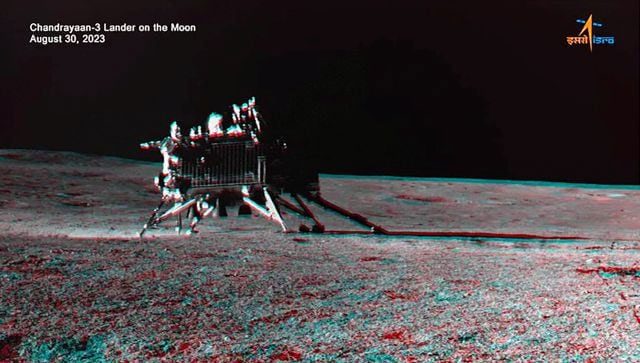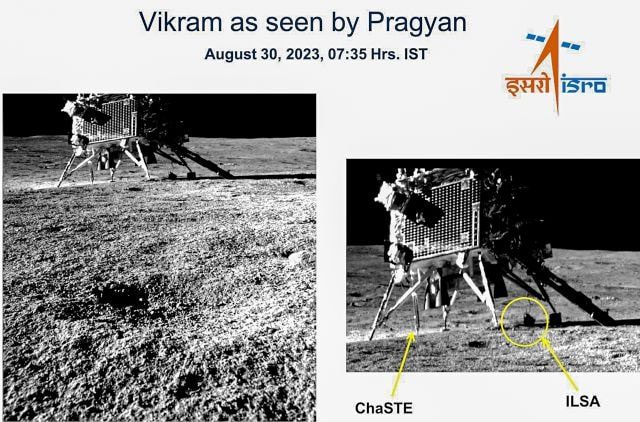Reuters reports that the Indian Space Research Organisation (ISRO) has confirmed that the Vikram lander and Pragyan rover from the Chandrayaan-3 lunar mission did not awaken on September 22 as initially planned, while Indian scientists continue to work on ways to “wake” them up.
Previously, the Chandrayaan-3 mission, which successfully landed on August 23, made India the fourth country in history to land on the Moon, following the United States, the former Soviet Union, and China.
In the two weeks that followed, the Pragyan rover explored the landing site, which is located in the South Pole region of the Moon, while the Vikram lander conducted a series of experiments, including measuring the temperature of the upper layer of the lunar crust.

3D image of Vikram lander on the south pole of the Moon. (Photo: PTI).
According to Firstpost (India), the Pragyan rover entered sleep mode on September 2, while the Vikram lander did so on September 4 when night fell on the Moon and the battery power ran low. The next sunrise on the Moon was on September 22. ISRO hopes that the solar panels will recharge and awaken the duo.
After initiating sleep mode for the rover, ISRO stated: “The rover has completed its mission. It is now safely parked and in sleep mode… Currently, the battery is fully charged. The solar panels are oriented to receive sunlight at the next dawn expected on September 22, 2023…”
The European Spaceport in Kourou (on the French Guiana) and the ISRO Telemetry, Tracking and Command Network (ISTRAC) in Bengaluru (India) have sent signals but have received no response.
Harsh Conditions on the Moon
According to scientists, nighttime temperatures on the Moon are extremely low. Temperatures near the lunar poles can drop from minus 180 degrees Celsius to minus 253 degrees Celsius. The Vikram lander and Pragyan rover were not designed to survive such extreme conditions. With complete darkness on the Moon, the solar-powered mission could not recharge its batteries. It is also possible that their batteries have been adversely affected by the extreme cold.
Manish Purohit, a former ISRO scientist who participated in the Chandrayaan-2 and Mangalyaan missions and is an expert in solar batteries, said: “Vikram and Pragyan were expected to awaken after surviving the harsh nights on the Moon, where temperatures drop to minus 180 degrees Celsius. The chances of revival depend entirely on the remaining solar panels after the long nights on the Moon.”
A.S. Kiran Kumar, former Chairman of ISRO, stated that many components may not survive the harsh conditions on the Moon.

Illustration of the Pragyan rover from the Chandrayaan-3 mission moving on the lunar surface. (Photo: PTI).
According to a report on Space.com, the Vikram lander and Pragyan rover were not equipped with heaters typically used for lunar missions.
“These heaters, known as Radioisotope Heater Units (RHU), work by radiating passive heat to keep the spacecraft hardware at a stable operational temperature. Typically, RHUs are used in space missions to convert heat generated from the natural decay of radioactive versions of plutonium or polonium into electrical energy. This process ultimately warms the spacecraft hardware, although just enough to help it survive in very cold temperatures,” the report stated.
Without heaters, the survival chances of Vikram and Pragyan are very slim.
Is There Still a Chance for Revival?
M. Sankaran, Director of the UR Rao Satellite Centre, which leads the Chandrayaan-3 mission, stated: “The lander and the rover have not yet awakened. Although the chances of them waking up after the night on the Moon ends in the next 14 days are very slim, we will not lose hope.”
ISRO previously mentioned that if the duo does not awaken, “they will remain there as India’s lunar ambassadors.”
According to Firstpost, Vikram and Pragyan were not designed to return to Earth.

In an image released by ISRO on August 30, the Vikram lander is seen on the lunar surface as captured by the navigation camera (NavCam) on the Pragyan rover.
What Has the Chandrayaan-3 Mission Achieved?
Despite multiple attempts to wake up the Vikram and Pragyan duo failing, S. Somanath, Chairman of ISRO, believes that the lunar mission has largely succeeded as it has achieved its set goals. The head of ISRO previously told the media: “It’s okay if it doesn’t wake up because the rover has done what it was meant to do.”
According to Firstpost, the primary goal of the mission was to land the spacecraft softly on the Moon. With this, India has joined the ranks of a select few countries that have achieved this feat, including the United States, China, and the former Soviet Union. India also became the first country to land near the southern pole of the lunar surface.
During this mission, the rover traveled approximately 100 meters and detected the presence of several elements on the Moon, including the first discovery of sulfur.
Therefore, ISRO believes that the mission has succeeded beyond expectations.


















































